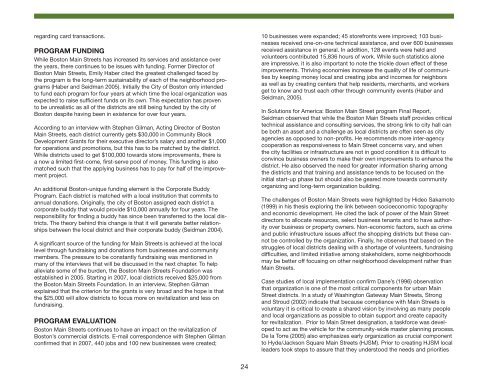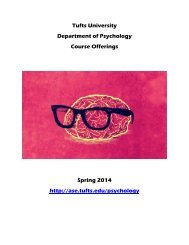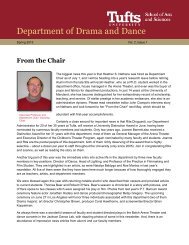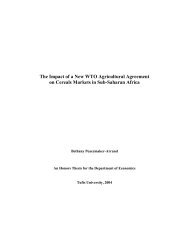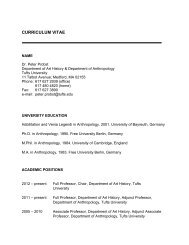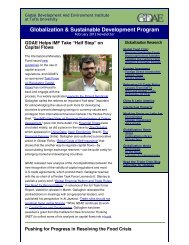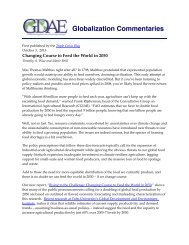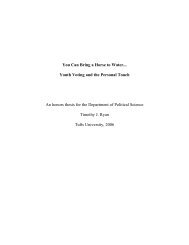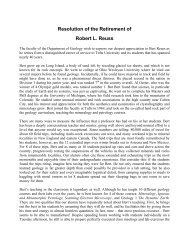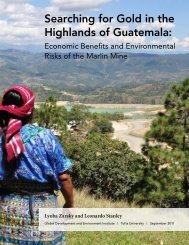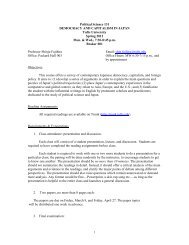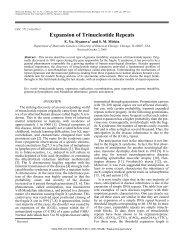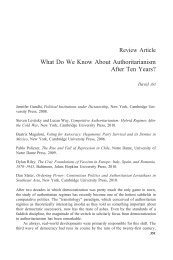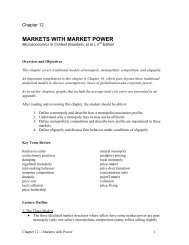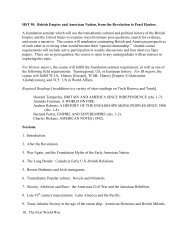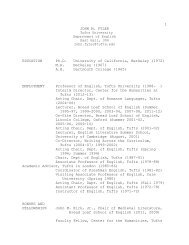Is A Main Street Program Appropriate for Mattapan? - Tufts University
Is A Main Street Program Appropriate for Mattapan? - Tufts University
Is A Main Street Program Appropriate for Mattapan? - Tufts University
You also want an ePaper? Increase the reach of your titles
YUMPU automatically turns print PDFs into web optimized ePapers that Google loves.
egarding card transactions .<br />
PRoGRaM fUnDInG<br />
While Boston <strong>Main</strong> <strong>Street</strong>s has increased its services and assistance over<br />
the years, there continues to be issues with funding . Former Director of<br />
Boston <strong>Main</strong> <strong>Street</strong>s, Emily Haber cited the greatest challenged faced by<br />
the program is the long-term sustainability of each of the neighborhood programs<br />
(Haber and Seidman 2005) . Initially the City of Boston only intended<br />
to fund each program <strong>for</strong> four years at which time the local organization was<br />
expected to raise sufficient funds on its own . This expectation has proven<br />
to be unrealistic as all of the districts are still being funded by the city of<br />
Boston despite having been in existence <strong>for</strong> over four years .<br />
According to an interview with Stephen Gilman, Acting Director of Boston<br />
<strong>Main</strong> <strong>Street</strong>s, each district currently gets $30,000 in Community Block<br />
Development Grants <strong>for</strong> their executive director’s salary and another $1,000<br />
<strong>for</strong> operations and promotions, but this has to be matched by the district .<br />
While districts used to get $100,000 towards store improvements, there is<br />
a now a limited first-come, first-serve pool of money . This funding is also<br />
matched such that the applying business has to pay <strong>for</strong> half of the improvement<br />
project .<br />
An additional Boston-unique funding element is the Corporate Buddy<br />
<strong>Program</strong> . Each district is matched with a local institution that commits to<br />
annual donations . Originally, the city of Boston assigned each district a<br />
corporate buddy that would provide $10,000 annually <strong>for</strong> four years . The<br />
responsibility <strong>for</strong> finding a buddy has since been transferred to the local districts<br />
. The theory behind this change is that it will generate better relationships<br />
between the local district and their corporate buddy (Seidman 2004) .<br />
A significant source of the funding <strong>for</strong> <strong>Main</strong> <strong>Street</strong>s is achieved at the local<br />
level through fundraising and donations from businesses and community<br />
members . The pressure to be constantly fundraising was mentioned in<br />
many of the interviews that will be discussed in the next chapter . To help<br />
alleviate some of the burden, the Boston <strong>Main</strong> <strong>Street</strong>s Foundation was<br />
established in 2005 . Starting in 2007, local districts received $25,000 from<br />
the Boston <strong>Main</strong> <strong>Street</strong>s Foundation . In an interview, Stephen Gilman<br />
explained that the criterion <strong>for</strong> the grants is very broad and the hope is that<br />
the $25,000 will allow districts to focus more on revitalization and less on<br />
fundraising .<br />
PRoGRaM eValUaTIon<br />
Boston <strong>Main</strong> <strong>Street</strong>s continues to have an impact on the revitalization of<br />
Boston’s commercial districts . E-mail correspondence with Stephen Gilman<br />
confirmed that in 2007, 440 jobs and 100 new businesses were created;<br />
24<br />
10 businesses were expanded; 45 storefronts were improved; 103 businesses<br />
received one-on-one technical assistance, and over 600 businesses<br />
received assistance in general . In addition, 128 events were held and<br />
volunteers contributed 15,836 hours of work . While such statistics alone<br />
are impressive, it is also important to note the trickle down effect of these<br />
improvements . Thriving economies increase the quality of life of communities<br />
by keeping money local and creating jobs and incomes <strong>for</strong> neighbors<br />
as well as by creating centers that help residents, merchants, and workers<br />
get to know and trust each other through community events (Haber and<br />
Seidman, 2005) .<br />
In Solutions <strong>for</strong> America: Boston <strong>Main</strong> <strong>Street</strong> program Final Report,<br />
Seidman observed that while the Boston <strong>Main</strong> <strong>Street</strong>s staff provides critical<br />
technical assistance and consulting services, the strong link to city hall can<br />
be both an asset and a challenge as local districts are often seen as city<br />
agencies as opposed to non-profits . He recommends more inter-agency<br />
cooperation as responsiveness to <strong>Main</strong> <strong>Street</strong> concerns vary, and when<br />
the city facilities or infrastructure are not in good condition it is difficult to<br />
convince business owners to make their own improvements to enhance the<br />
district . He also observed the need <strong>for</strong> greater in<strong>for</strong>mation sharing among<br />
the districts and that training and assistance tends to be focused on the<br />
initial start-up phase but should also be geared more towards community<br />
organizing and long-term organization building .<br />
The challenges of Boston <strong>Main</strong> <strong>Street</strong>s were highlighted by Hideo Sakamoto<br />
(1999) in his thesis exploring the link between socioeconomic topography<br />
and economic development . He cited the lack of power of the <strong>Main</strong> <strong>Street</strong><br />
directors to allocate resources, select business tenants and to have authority<br />
over business or property owners . Non-economic factors, such as crime<br />
and public infrastructure issues affect the shopping districts but these cannot<br />
be controlled by the organization . Finally, he observes that based on the<br />
struggles of local districts dealing with a shortage of volunteers, fundraising<br />
difficulties, and limited initiative among stakeholders, some neighborhoods<br />
may be better off focusing on other neighborhood development rather than<br />
<strong>Main</strong> <strong>Street</strong>s .<br />
Case studies of local implementation confirm Dane’s (1996) observation<br />
that organization is one of the most critical components <strong>for</strong> urban <strong>Main</strong><br />
<strong>Street</strong> districts . In a study of Washington Gateway <strong>Main</strong> <strong>Street</strong>s, Strong<br />
and Stroud (2002) indicate that because compliance with <strong>Main</strong> <strong>Street</strong>s is<br />
voluntary it is critical to create a shared vision by involving as many people<br />
and local organizations as possible to obtain support and create capacity<br />
<strong>for</strong> revitalization . Prior to <strong>Main</strong> <strong>Street</strong> designation, a task<strong>for</strong>ce was developed<br />
to act as the vehicle <strong>for</strong> the community-wide master planning process .<br />
De la Torre (2005) also emphasizes early organization as crucial component<br />
to Hyde/Jackson Square <strong>Main</strong> <strong>Street</strong>s (HJSM) . Prior to creating HJSM local<br />
leaders took steps to assure that they understood the needs and priorities


